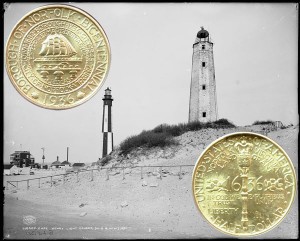Today, the Norfolk Virginia Commemorative Silver Half Dollar Coin tells the story of the darkened lighthouses 202 years ago.
The Niles Weekly Register from 1813 provides insights into the issues and actions of the war with Britain.
In particular, the lighthouses on the Chesapeake were targets of the British navy as shown in the examples below.
First, February 14, 1813:
“A band of veterans from the British squadron, landed at the light house on Cape Henry, and bravely attacked the pantry and smoke house of the keeper, and captured his hams, minced pies and sausages after which they returned with flying colors to their ships. ‘England expects every man to do his duty!’ This brilliant affair took place on the 14th instant.”
In their efforts to undermine the Americans, the British set up a blockade across the Chesapeake.
In March, the Register reported:
“The blockade of the Chesapeake continues with unremitted rigor. Nothing very important has reached us since our last, except that on the 10th inst. the enemy’s squadron came up as far as Hampton Roads, where they anchored. One of the frigates came into the Roads, and after tacking and maneuvering for some time, put back and anchored under Old Point Light.
“Such is the position of the enemy that it is unsafe to cross the Roads. The mail boat from Hampton to Norfolk had not ventured over and the usual rout of the northern mail is cut off. The Constellation is anchored in the bite of Craney Island, the gun boats are stationed on the flats in her rear—the forts are in fine condition, with a sufficiency of brave spirits to man them.
“We wait with great anxiety for further news from Norfolk, and trust in God and the valor of our countrymen, that the enemy will repent his town-destroying policy.”
With the activity in the bay, Washington ordered the Chesapeake lighthouses darkened:
“Notice is hereby given—That the lights of the lighthouse on Cape Henry, and also of all the other lighthouses in the Chesapeake, will be immediately extinguished. Albert Gallatin. Treasury Department, March 16th, 1813.”
The darkened lighthouses limited British advances during nighttime and storms, however they continued their offensive in the bay.
In July 1813, their pillaging had a different outcome as reported in the Register:
“The enemy had been in the practice for some time past of coming on shore frequently, near the lighthouse, on Cape Henry, where they had sunk wells and obtained a partial supply of water, and also plundered the inhabitants.
“About 50 of the Princess Anne county militia, commanded by Captain Robert Lawson determined to ‘correct the procedure,’ and fixed themselves in ambuscade behind some sand hills, within about forty yards of the wells.
“A barge with 26 men came on shore early in the morning of the 14th,and all hands proceeded to the watering place.
“When they arrived, Captain Lawson perceiving the disparity of their force, called out to them to surrender; for which one of the lieutenants leveled a carbine at his head, and fired. It missed.
“The militia then gave them a full round—three marines were killed, one lieutenant, two seamen and two marines wounded.
“They were panic struck and fled to the boat without further resistance; were pursued and made prisoners, sustaining no other hurt.
“The boat was destroyed; a brass cannon and everything on board that could be removed, were taken away.
“The prisoners, two lieutenants, 16 seamen and five marines, have arrived in Norfolk. The wounded have been taken care of.
“None of our people were injured.”
The Norfolk Virginia Commemorative Silver Half Dollar Coin shows against a view of the old and new Cape Henry lighthouses, circa 1905.
